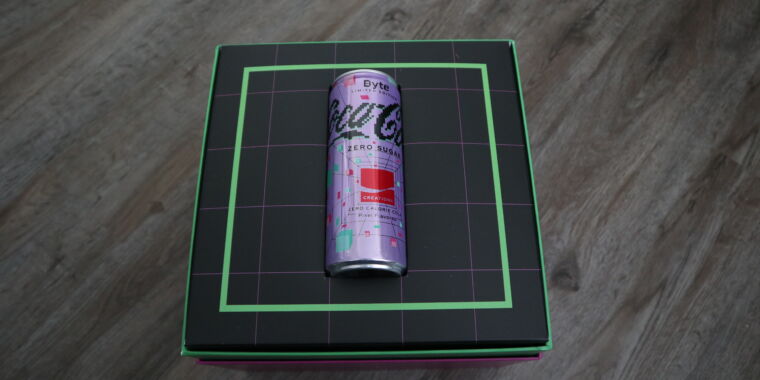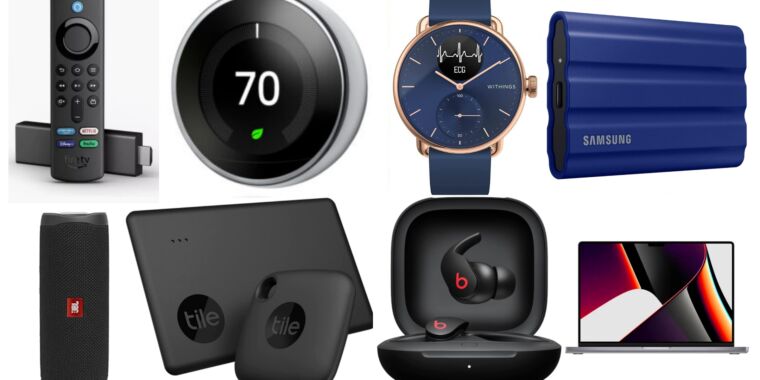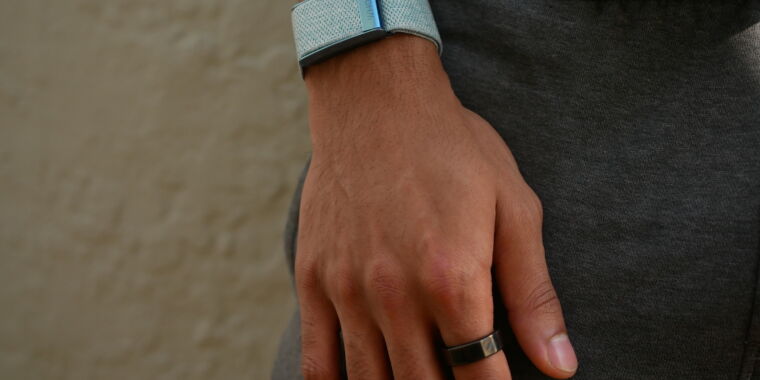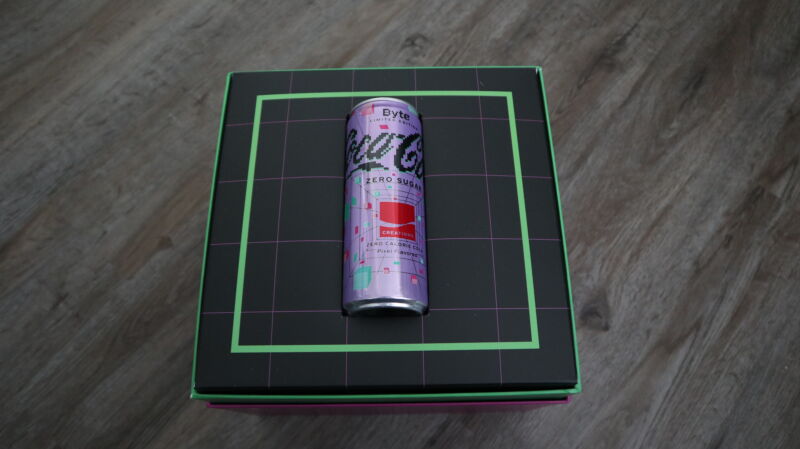
Sam Machkovech
If you’re looking for a TL;DR on what the first “gamer” flavor of Coca-Cola tastes like, I can answer that at the top: It’s weird. Blueberry, maybe? But only if a blueberry was dunked in a pool of Red Bull. That’s “Coca-Cola Byte.”
Upon its announcement, I asked Coca-Cola if I could sample Byte, slated to launch in the United States in early May, because I found its gaming-adjacent existence fascinating. Many other soda and junk-food makers have enjoyed a cozy commercialization relationship with video games for decades—so much so that you can close your eyes and imagine a stereotypical “gamer” holding a sugary, carbonated beverage by default. (It’s probably Mountain Dew. So much “gamer” Mountain Dew out there.)
-
Coca-Cola Byte’s recycling plea, written with gamer-specific encouragement.
Sam Machkovech -
Coca-Cola Byte only comes in a sugar-free version. All judgments rendered in this article come from someone who prefers sugar-free sodas and colas, cancer risk be damned.
Yet somehow, Coke has avoided direct tie-ins with the gaming universe in most of the world. We’ve never seen limited-edition Super Mario cans of Coke. We’ve never had bottles of Coke hide codes under their caps that give away free XP in online games. And the stuff basically never appears inside games’ virtual worlds, despite so many brands clamoring to capture gamers’ eyeballs and disposable budgets.
A Creations primer, from Starlight to Byte
That changed this month with Byte, which Coca-Cola advertises as “inspired by the humble and iconic pixel.” Its advertising card about this fact poses a can of Byte on a Tron-like grid of black, green, and violet neon lines, next to two colored 3D blocks. (Are those supposed to be pixels? They have a Z-axis, Coca-Cola, so they’re technically polyhedrons.) And its launch was paired with a Fortnite “creator island” zone, full of Coca-Cola branding (but made by an advertising agency, not Epic Games). So I had to know: What did all of this look and taste like, and how did it fit into the games-and-soda pantheon?
-
Inspired by a “pixel” that is rendered here as a 3D shape? Whatever you say, Coca-Cola.
-
Seriously, did nobody think about how easy it is to add an “S” here?
If you’re wondering where Coke is going with this on a pure flavor basis, look to the Coca-Cola Creations line of limited-time sodas. The first one, dubbed Coca-Cola Starlight, launched earlier this year and was pretty decent—at least, in a world where every cola flavor is seemingly possible if you experiment for long enough with one of those Coca-Cola Freestyle machines. In Starlight’s case, Coke mixed cinnamon and cream-soda syrups into its standard formula, resulting in something best described as Coke Roasted Marshmallow. Unique! Drinkable! Not bad. Doesn’t necessarily pair with Doritos, though.
Byte, on the other hand, goes for an out-there, fruit-forward flavor, and I had someone photograph my first impressions as I sipped it. For context, I liked the atypical Starlight flavor, and I can appreciate bold, weird, and sweet flavors. In particular, I manned the soda fountain at a fast-food joint during high school, where I engineered a bizarre mix of pink lemonade, root beer, and lemon-lime soda as a daily driver, much to my coworkers’ dismay.
And yet:
-
First, the Coca-Cola Byte sniff. Wow, that’s a strong berry-acid aroma. Not a scent I necessarily associate with gamers.
Sam Machkovech -
Immediately swishing Coca-Cola Byte around the mouth.
-
This is the face of Coca-Cola Byte taste-test regret.
I eventually drank the rest of the single can I received, and it arguably got better a few days later without carbonation—revealing more raspberry flavor. But unlike Starlight, or even standard grocery aisle variants like vanilla and cherry, Byte’s mix of new flavors loudly punts Coke’s recognizable nutmeg base. It may still be there, buried beneath this drink’s lab-generated berry formulation, but the recognizable Coke core is virtually nonexistent in this drink.
And, yeah, it pairs decently with snacks like tortilla chips. But that’s because the chips’ texture and saltiness balance the phosphoric acid-driven kick.
Avoiding the laser-beam eyes of Coke Legal
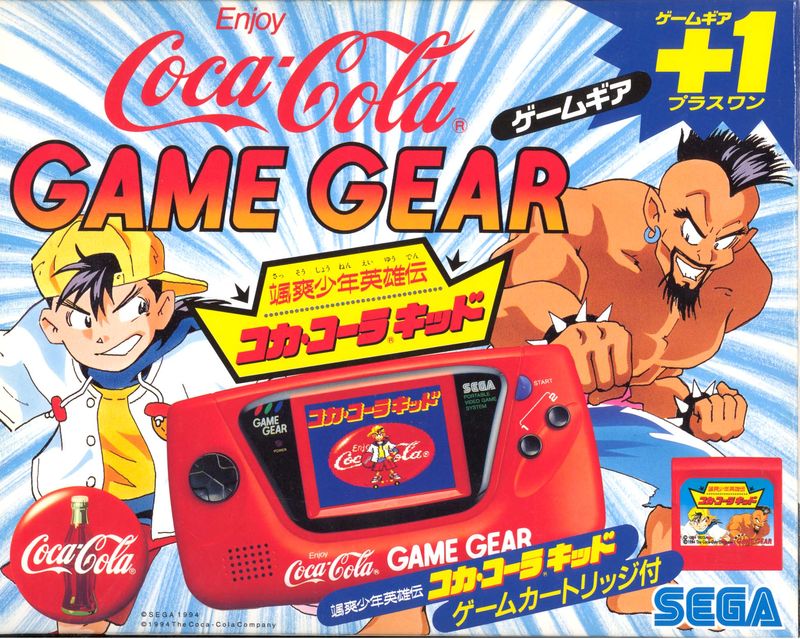
Byte is technically Coke’s second overt gaming tie-in. The first came in 1994 as a Japan-only Game Gear game, made by a longtime Japanese Sega support studio, and it revolved around Japan’s mid-’90s Coca-Cola Kid mascot. Maybe Coke’s Japanese office felt like this exception to the company’s history was okay if it happened on the go—and the game was played on the Japan-exclusive Coca-Cola Game Gear model, which was as red as a can of Coke. Either way, players must run, jump, kick, skateboard, and throw red frisbees around a colorful city while beating up anyone who gets between Coca-Cola Kid and his Coke habit.
Beyond that game, the Coca-Cola company has been surprisingly mum inside of the billion-dollar gaming industry. That stands in stark contrast to film and TV, where the company is obsessive about finding ways to get its variety of drinks into productions—and it has a massive network of company historians, product placement specialists, and supply-chain assistants eager to make sure you see as much freaking Coke in your entertainment as possible. Era-appropriate signs, cans from the ’80s, desperation to make SmartWater seem like something modern people like: They have it all… so long as the content in question is, as a Coke marketing person puts it, “in line with [Coke’s] brand values and strategically in line with where we’re going as a company.”
Statements like that are the best we have to understand Coke’s general gaming absence: They likely didn’t think having their products in games reflected well on the brand. Even so, Coke and its sugar-water rivals had all the opportunity in the world to organically appear as branded elements in decades of games. This Tumblr site will let you spend hours clicking through the robust history of soda machines in video games, and brightly colored aluminum cans have often served as an arcade-style health item. The most Coke-like of these virtual cans appears in Data East’s 1991 arcade blaster Desert Assault, and if the game ever saw a formal re-release, it’d honestly need a touch-up to avoid the laser-beam eyes of Coke Legal.

